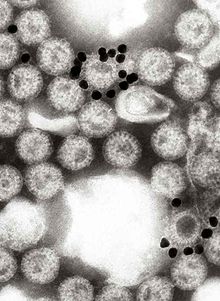User:Ajpolino/IEM
Appearance
Immune electron microscopy is a type of EM used to diagnose some viral infections.[1]
It is difficult.[2]
IEM was developed for identifying transmissible gastroenteritis viruses, e.g. rotavirus in feces.[3]
IEM is fast and sensitive. IEM relies on antibody-virus complexes.[4]
Procedure
[edit]
Was copy/pasted from this ref.[5]
Application
[edit]This was a bit of a hodgepodge:
While IEM is good for recognizing hepatitis A antigen, it's challenging to scale up.
In 1973, Feinstone et al. used IEM to find hepatitis A virus in prisoners.[6]
IEM can detect potato viruses.[7]
IEM can detect plant viruses.[8]
References
[edit]- ^ Orthopoxviruses Pathogenic for Humans. 2006-06-09. ISBN 9780387253060.
- ^ Bradley, David E. (1984). "Characteristics and Function of Thick and Thin Conjugative Pili Determined by Transfer-derepressed Plasmids of Incompatibility Groups It, Ia, Is, B, K and Z" (PDF). Microbiology. 130 (6): 1489–1502. doi:10.1099/00221287-130-6-1489. PMID 6148378. Retrieved 1 October 2018.
{{cite journal}}: CS1 maint: unflagged free DOI (link) - ^ Saif, LJ; Bohl, EH; Kohler, EM; Hughes, JH (1977). "Immune electron microscopy of transmissible gastroenteritis virus and rotavirus (reovirus-like agent) of swine". American Journal of Veterinary Research. 38 (1): 13–20. PMID 189646.
- ^ Katz, D; Straussman, Y; Shahar, A; Kohn, A (1980). "Solid-phase immune electron microscopy (SPIEM) for rapid viral diagnosis". Journal of Immunological Methods. 38 (1–2): 171–4. doi:10.1016/0022-1759(80)90341-5. PMID 7452001.
- ^ "Immuno-Electron Microscopy". umassmed.edu. 2013-11-02. Retrieved 1 October 2018.
- ^ Dienstag, Jules L.; Purcell, Robert H. (1977). "Recent advances in the identification of hepatitis viruses*" (PDF). Postgraduate Medical Journal. 53 (621): 364–373. doi:10.1136/pgmj.53.621.364. Retrieved 1 October 2018.
- ^ Gars, I. D.; Paul Khurana, S. M. (1991). Horticulture — New Technologies and Applications. Current Plant Science and Biotechnology in Agriculture. Vol. 12. pp. 329–336. doi:10.1007/978-94-011-3176-6_52. ISBN 978-94-010-5401-0.
- ^ Shukla, D. D.; Gough, K. H. (1979). "The Use of Protein A, from Staphylococcus aureus, in Immune Electron Microscopy for Detecting Plant Virus Particles" (PDF). Journal of General Virology. 45 (2): 533–536. doi:10.1099/0022-1317-45-2-533. Retrieved 1 October 2018.
